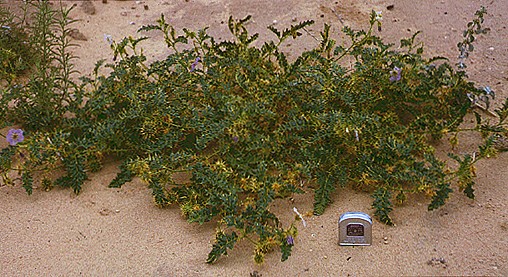 Photo: D.E.Symon 722A © D.E.Symon |
 Line drawing by M. Szent Ivany, J. Adelaide Bot. Gards 4 (1981) 237, fig. 104. |
 Distribution map generated from Australia's Virtual Herbarium . |

Synonymy
Solanum hystrix R. Br., Prodr. 446 (1810)
T: Anchorage 5 (Franklin Isles, S.A.) Feb. 1802, R. Brown s.n.; lecto: BM; fide D.E. Symon, J. Adelaide Bot. Gard. 4: 237 (1981). Images of Brown's collections can be found on the Solanaceae Source site.
Description
Sprawling, clonal, herbaceous perennial with usually annual stems to 25 cm long, green or greenish-yellow, almost glabrous to sparsely pubescent with simple hairs, occasional stellate hairs and minute glandular hairs; prickles to 15 mm long, abundant on all parts except corolla.
Leaves elliptic; lamina 3–7 cm long, 1–3 cm wide, sometimes larger, almost concolorous, lobed; lobes obtusely triangular, shallowly lobed; petiole usually up to 15 mm long.
Inflorescence 1–10–flowered; peduncle 5–10 mm long; rachis 1–3 cm long; pedicels 5–10 mm long. Calyx 4–8 mm long, enlarged in fruit; lobes narrowly triangular, 2–4 mm long. Corolla broadly stellate to rotate, 15–25 mm diam., pale blue or white. Anthers 5 mm long.
Berry globular, 15–25 mm diam., drying blackish; fruiting peduncle to 30 mm long, pedicels 15–20 mm long, calyx c. 15–25 mm diam. Seeds 2–2.5 mm long, dark grey to almost black. n=12.
Distribution and ecology
Native to Eyre Peninsula region and adjacent offshore islands of S.A.; introduced populations locally established in south-eastern S.A., N.S.W. and W.A.
Usually occurs on sandy plains; common in recently burnt scrub.
Common name
Afghan Thistle, Porcupine Solanum.
Relationships
Closely related to S. hoplopetalum Bitter & Summerh., but distinguished by being almost glabrous.
Considered by Bean (2004) to be a member of the S. hystrix group of subgen. Leptostemonum.
Martine et al. (2006 & 2009) included S. hoplopetalum in their molecular study of the dioecious species of the Dioicum group and indicated in the second of these papers that S. hoplopetalum (a hermaphrodite species) was part of a clade composed of the andromonoecious Solanum species from Africa and Australia. Since S. hystrix and S. hoplopetalum are closely related (see above; confirmed in Martine et al., 2006) it is assumed that this relationship will also be true of S. hystrix, and possibly of the rest of the species composing the S. hystrix group.
References: Martine, C.T., D. Vanderpool, G.J. Anderson, and D.H. Les (2006). Phylogenetic relationships of andromonoecious and dioecious Australian species of Solanum subgenus Leptostemonum section Melongena: Inferences from ITS sequence data. Systematic Botany 31: 410-420; Martine, C.T., G.J. Anderson & D.H. Les (2006). Gender-bending aubergines; molecular phylogenetics of cryptically dioecious Solanum in Australia. Australian Systematic Botany 22: 107-120.
Notes
The treated fruit were eaten by Aborigines. Reproduced below is a an account of how the fruit was prepared and other observations of the plant by Annie F. Richards in the Transactions of the Royal Society of South Australia, volume 3, page 136 (1880).
"The native name of this plant is "walga". The blacks use the fruit for food, but only with the pounded and baked bark of the mallee root called "coongoo" by them. Before using the fruit they take off the shell (the prickly dry calyx) and remove the seeds. This leaves a pulpy skin about the thickness of that of a native peach; the fruit and bark are then made into a cake. When fruits are not obtainable, and they are otherwise hard pressed for food, the native bleed themselves in the arm and used the blood with the bark. The natives told me, when opening the fruit for the seeds, not to eat the fruit, as it would make my throat sore, nor yet to touch my eyes with my fingers. The fine prickles and juice got into my fingers and produced a good deal of pain and inflammation for a short time. The plant droops as soon as gathered, and the leaves wither very much in drying; the flowers are at first dark lavender, but after a time become quite white; the seeds are of a black or brown colour. It is common in this district, but only growing in sandy soil; it prevails in burnt scrub lands, if rain follows soon after the fire. I have seen it forty miles north from Point Bell, and nearly sixty miles east of Fowler's Bay; it grows sparingly at Fowler's Bay. The fruit first ripens about the end of February, when the plant dies off; young plants spring again at any time after rain, so that there may be two crops in a year, as it is here with many plants. Camels eat the plant."
The plant is clearly native but the common name, Afghan Thistle, is a clear reference to the misconception that this prickly plant is an introduction spread by the Afghan people. It could be that the distributional range of the species has been increased by the Afghani traders and their camels, but it is equally likely that it has been spread further by farming and roadmaking activities.
Selected specimens
W.A.: c. 165 km E of Norseman, 20 May 1968, G. Howard (PERTH); S.A.: near Cummins, C.R. Alcock 2260 (AD); near Kimba, D.E. Symon 4482 (AD, CANB, NSW); Ceduna, 2 Nov. 1950, J.H. Willis (MEL).
From the web
A fact sheet for this species can be downloaded from the eFlora SA site.
Further information on this species in NSW can be seen on the PlantNET site and for WA on the FloraBase site.
Limited information and links for this species can be found on the Solanaceae Source site.